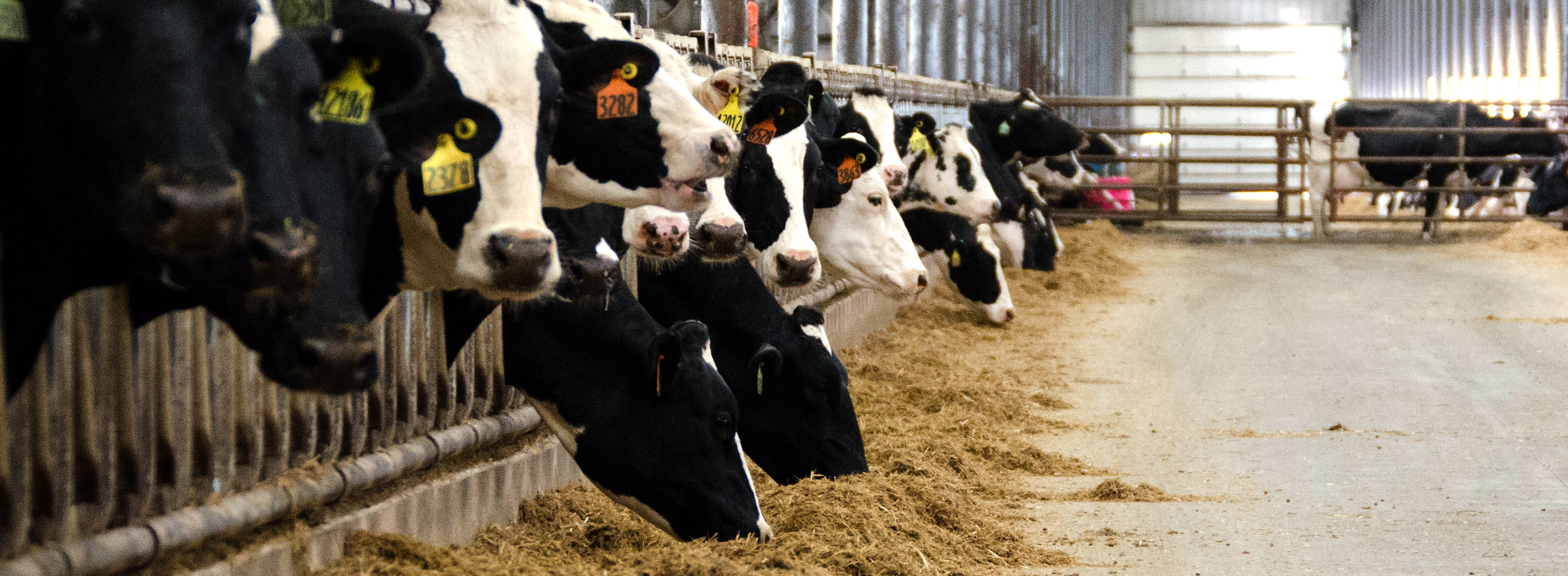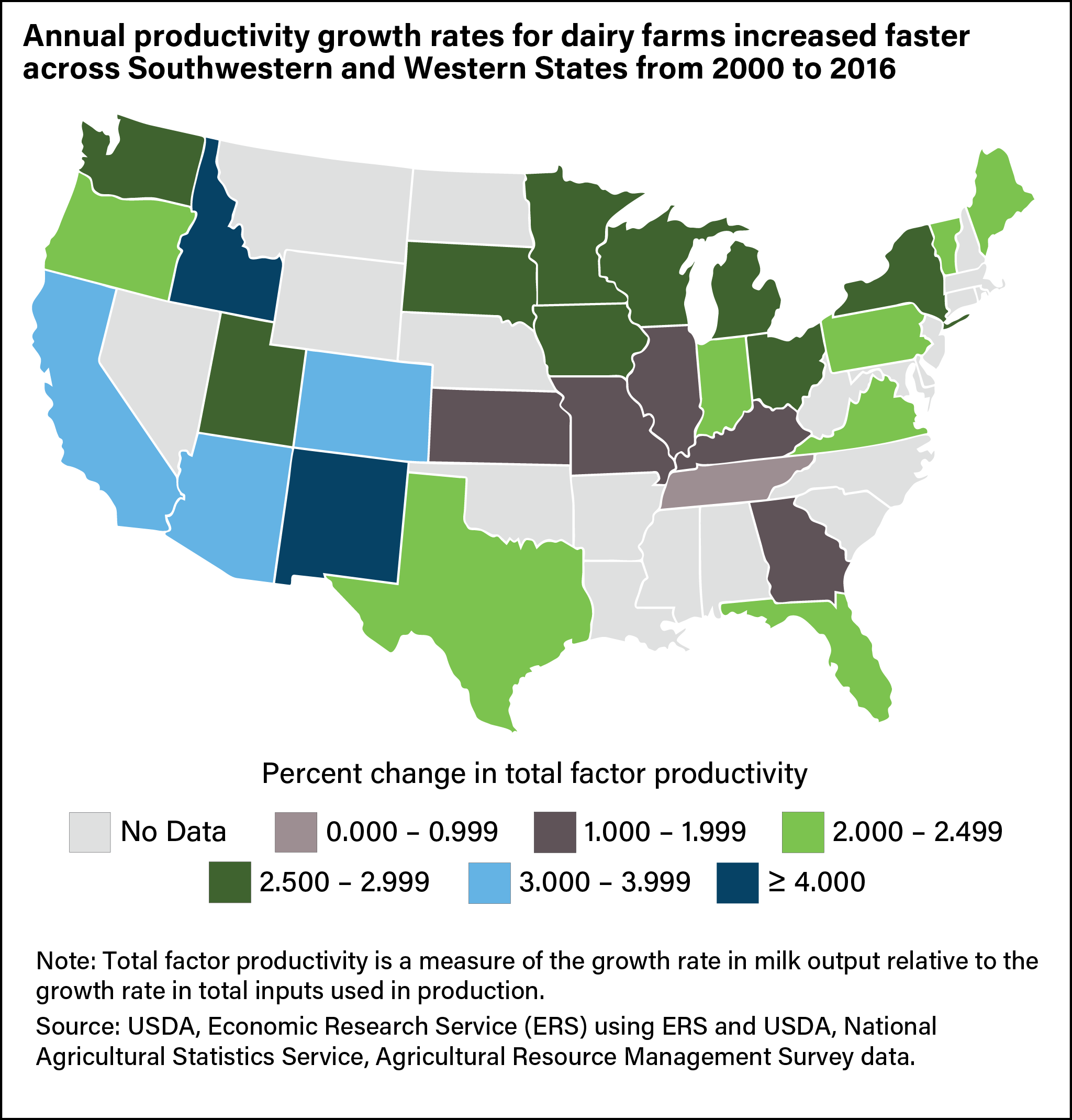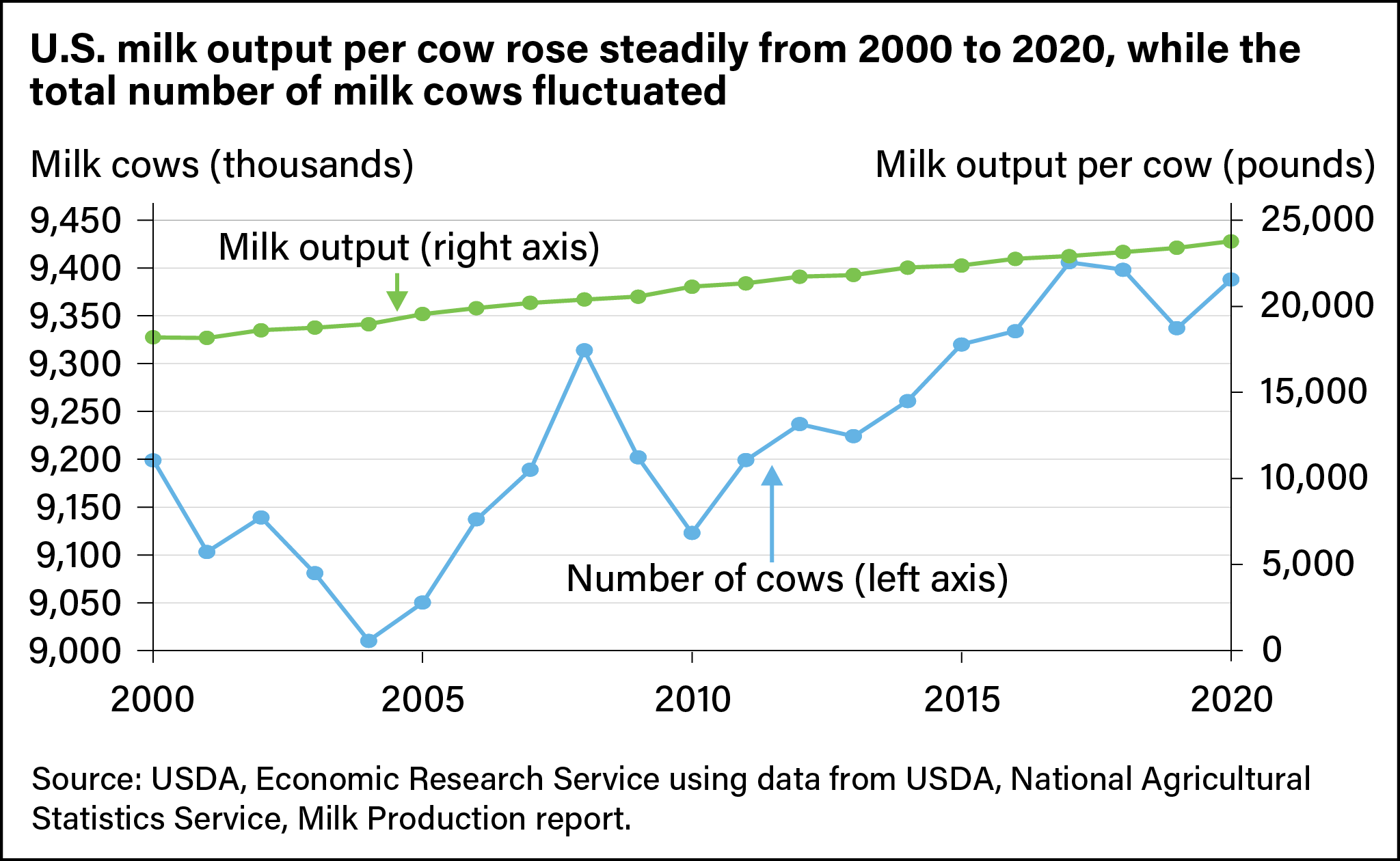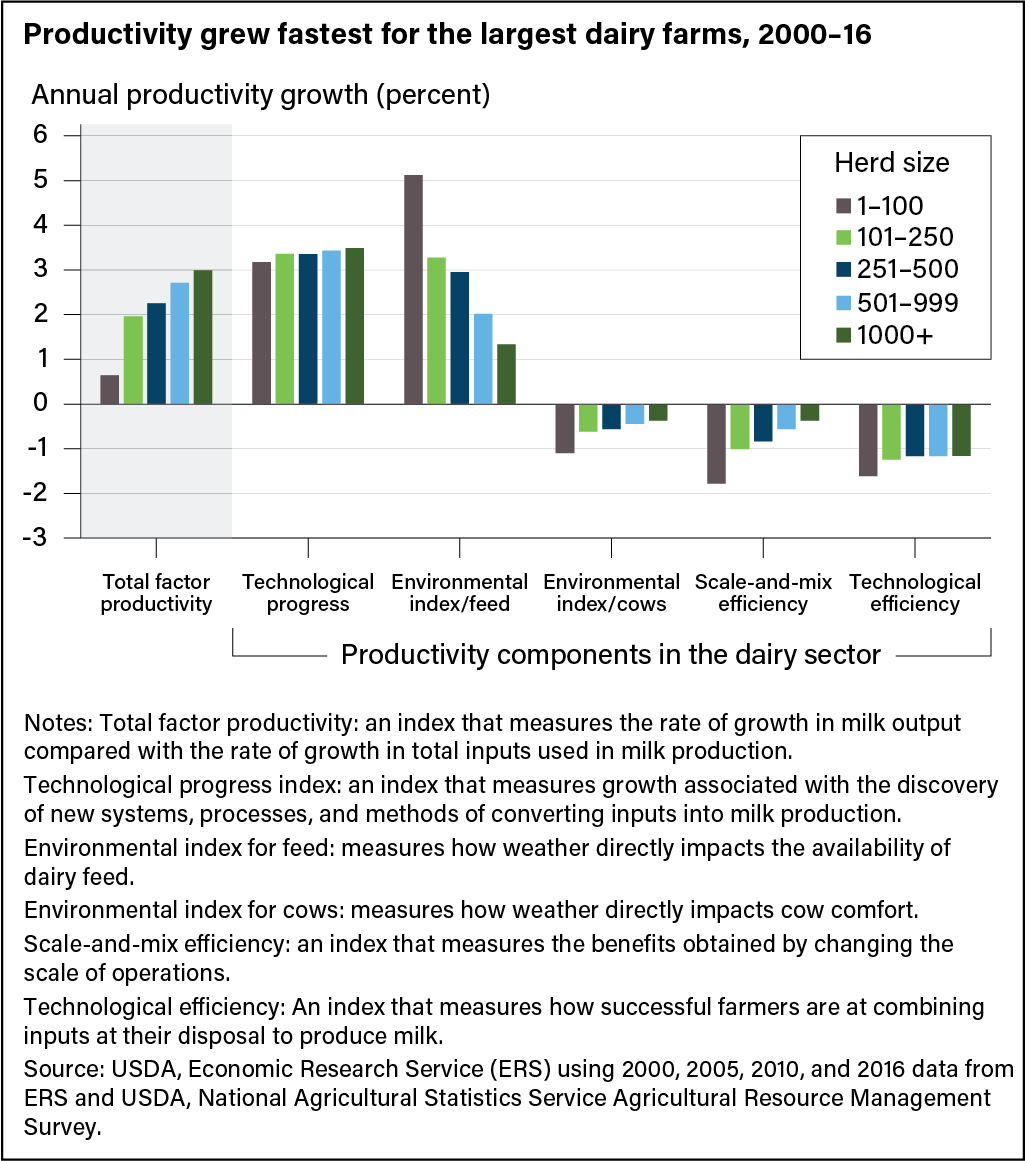
U.S. Dairy Productivity Increased Faster in Large Farms and Across Southwestern States
- by Eric Njuki
- 3/22/2022
Highlights
- Productivity in dairy operations grew fastest for larger farms, those with more than 1,000 milk cows, and for farms in the West and Southwest United States.
- The primary driver behind productivity growth was technological progress, which is characterized by innovations in areas such as genetics, breeding, and equipment. Environmental factors such as extreme temperatures, floods, droughts, and intense storms reduced dairy production by changing the physiological functioning and reproductive health of cows.
- Productivity growth in organic dairy operations grew at a slower rate (0.66 percent) than conventional dairy farms (2.52 percent).
The U.S. dairy sector has undergone substantial structural change characterized by a shift to larger and fewer dairy operations concentrated in fewer States. In 2002, small operations with fewer than 100 milk cows numbered 73,725, representing 29 percent of the Nation’s herd. By 2017, this number dropped to 40,548, accounting for 13 percent of total dairy cows. In contrast, there were 1,256 large operations with more than 1,000 milk cows in 2002, representing 29 percent of the Nation’s herd. Fifteen years later, in 2017, this number rose to 1,953, and large farms managed 55.2 percent of all herds in the United States. Increasingly, these large dairy operations are located in the West, Southwest, and Upper Midwest regions of the country.
Moreover, the U.S. dairy sector has been able to produce more milk with fewer cows. From 2000 to 2020, the amount of milk produced per cow in the United States grew at an annual rate of 1.53 percent. Dairy farms produced 18,197 pounds of milk per cow in 2000, increasing to 23,777 pounds in 2020. Meanwhile, the size of the national herd increased from 9,199,000 in 2000 to 9,388,000 in 2020, an annual growth rate of only 0.10 percent. The productivity growth has not only freed up resources for other agricultural endeavors but also increased U.S. competitiveness in global markets.
Research from USDA’s Economic Research Service (ERS) measured productivity in the U.S. dairy sector using data from the Agricultural Resource and Management Survey (ARMS) that is conducted jointly by ERS and USDA, National Agricultural Statistics Service. The study tracked the growth of milk output over time while controlling for factors such as herd size, feed, capital, intermediate materials and services (such as veterinary work, electricity, fuel, fertilizers, and pesticides), and environmental factors such as rainfall and temperature.
From 2000 to 2016, productivity growth among dairy farms was widespread but with considerable variations according to region, farm size, and use of conventional or organic processes. Western and Southwestern States—especially Idaho, New Mexico, Arizona, and California—experienced the fastest productivity growth, with annual rates between 3.52 and 4.40 percent. Southern States—Kentucky, Georgia, Missouri, and Tennessee—were the slowest growing with annual rates ranging between 0.89 and 1.74 percent. Productivity across dairy farms with more than 1,000 milk cows grew at an annual rate of 2.99 percent, more than four times as fast as the smallest operations, which grew at 0.63 percent annually. Finally, productivity at organic dairy operations grew at a much slower pace compared with their conventional counterparts.
To better understand the sources of total factor productivity growth, researchers studied various economic components:
- technological progress—measuring productivity gains associated with the discovery of new knowledge, processes, and systems such as advanced equipment or genetic enhancement of milk cows;
- scale-and-mix efficiency—measuring productivity gains linked to changing the scale of operations;
- technical efficiency—measuring how successful farmers are at combining the materials and services at their disposal to maximize milk production; and
- environmental effects—measuring the effect of environmental factors such as precipitation, temperature, and soil quality on production.
The study found the primary driver behind productivity growth in the dairy sector was technological progress. Innovations that boosted productivity included improvements in genetics and selective breeding, better equipment such as milking machines, changes in barns to increase cow comfort, enhanced feed formulations, and more accurate digital record keeping. The environmental index for feed also showed positive growth even during periods of extreme weather.
On the other hand, several factors contributed to slower rates of productivity growth among dairy farms. One of those was a decline in the growth of scale-and-mix efficiency, indicating farms stand to benefit from expanding their scale of production. Declines in technical efficiency indicate some dairy operations did not combine inputs at their disposal efficiently enough to maximize milk output. Finally, environmental conditions such as extreme temperatures, floods, droughts, and frequent and intense storms also weighed on productivity growth. Such conditions can affect the availability and quality of feed as well as the physiological functioning and reproductive health of dairy cows. Negative environmental conditions also lead to the distribution and resiliency of parasites and pathogens that affect animal health.
Productivity Growth Slower for Organic Dairy Farms Than for Conventional Operations
An expanding sector within the dairy industry is organic milk production. Some smaller dairy farms facing economic pressures have converted to organic production. Although organic dairy farms incurred higher production costs than their conventional counterparts, they received higher gross returns. For example, in 2016, organic dairy producers on average earned $38.46 per hundredweight (cwt) compared with an average of $16.30 per cwt for conventional dairy operations.
Some production challenges remain. Organic dairy operations mostly rely on pasture-based feeding, which makes them more vulnerable to weather shocks and anomalies. Organic dairy operations use fewer labor-saving devices, which means higher labor costs. They also may face difficulties sourcing organic grains and forages, feed supplements, and replacement heifers. Productivity grew at an annual rate of 0.66 percent for organic dairy farms compared with 2.52 percent among conventional dairy operations.
This article is drawn from:
- Njuki, E. (2022). Sources, Trends, and Drivers of U.S. Dairy Productivity and Efficiency. U.S. Department of Agriculture, Economic Research Service. ERR-305.
You may also like:
- MacDonald, J.M. (2020, August 3). Scale Economies Provide Advantages to Large Dairy Farms. Amber Waves, U.S. Department of Agriculture, Economic Research Service.
- MacDonald, J.M., Law, J. & Mosheim, R. (2020). Consolidation in U.S. Dairy Farming. U.S. Department of Agriculture, Economic Research Service. ERR-274.
- Hutchins, J., Hueth, B. & Rosa, G. (2019). "Quantifying Heterogeneous Returns to Genetic Selection: Evidence from Wisconsin Dairies". National Bureau of Economic Research. DOI 10.3386/w26417.





